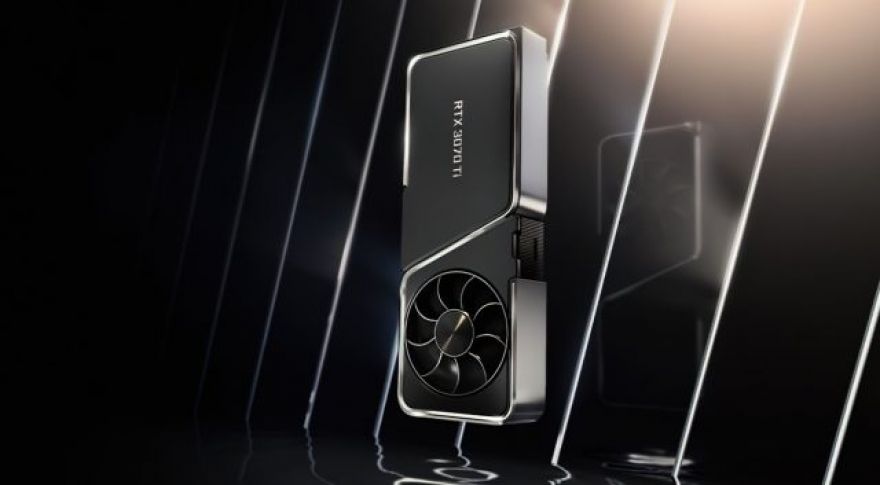
Nvidia RTX 3070 Ti: Mixed Reviews, Low VRAM a Long-Term Problem
Nvidia’s latest Ampere GPU is out today and we’ve rounded up reviews from multiple sources to cover opinions on the card. Up until today, Ampere has been hailed as one of Nvidia’s strongest architectures to date, and the RTX 3070 has been the relative star of the show.
The RTX 3070 Ti differs from the RTX 3080 Ti in multiple important respects.
Despite the name, the RTX 3080 Ti is effectively a replacement for the RTX 3090, so long as you don’t need the additional VRAM. The RTX 3070 Ti replaces 8GB of GDDR6 with 8GB of GDDR6X and boosts memory bandwidth by 1.36x.
We’re rounding up coverage from , , and our colleagues at . None of these publications are thrilled about the price/performance ratio being offered here. The RTX 3070 Ti offers a 1.2x increase in price (theoretically) with roughly a 1.07x increase in performance. We’ve embedded some of PCMag’s benchmarks below, but if you want to see their full suite of tests, including synthetic and multiplayer games, hit the full review.
PCMag writes, “Indeed, the RTX 3070 Ti, and its likely unobtanium status shortly after launch, makes a renewed case for the Radeon RX 6800, when you can find it, in the around-$600 price zone for 4K gaming.”
Ars believes the RTX 3070 Ti is a relatively poor value due to “how much an additional $100 nets you from an RTX 3080.” The Verge writes: “I can’t help but feel like 8GB will be challenging at some point during the lifetime of this card, so it’s a shame Nvidia only bumped the memory spec and not the size.”
8GB of RAM Is a Serious Ray Tracing Bottleneck
Normally, I don’t give much of my own opinion in these review roundups. I prefer to focus on the conclusions of the people writing the stories. In this case, however, I want to suggest any buyers considering the RTX 3070 or RTX 3070 Ti take a very careful look at how much VRAM limits the performance of this GPU.
When I reviewed the 6700 XT earlier this year, we found evidence that an 8GB memory buffer was insufficient to enable ray tracing at 4K for both the RTX 3080 and RTX 3070. The 12GB 6700 XT went from losing badly to the RTX 3070 to outperforming it at high resolution.
This evidence crops up again in the benchmarks some reviewers ran for the RTX 3070 Ti.
Image by Ars Technica
In Watch Dogs Legion, the RTX 3070 Ti manages 7.3fps without DLSS. The RTX 3070 is oddly faster (presumably due to driver immaturity), but it tops out at 9.6fps. The RTX 3080, in contrast, hits 31.4fps even in native 4K mode.
The 3.27x gap between RTX 3070 and RTX 3080 performance in native 4K is perfectly explained by the RTX 3070 running out of VRAM. This gap does not exist at 4K in WDL with RT disabled. The high performance of the RTX 2060 Super relative to the rest of the GPUs is a puzzle. Enabling DLSS kicks performance upwards to 32.5fps, from 9.6fps (or to 33.8fps, from 7.3fps). That’s because DLSS renders internally at a lower resolution before upscaling, and the RTX 3070’s VRAM buffer can handle the workload at this point.
Not all ray tracing games follow this pattern. Control shows no evidence of VRAM pressure and Cyberpunk 2077’s RT mode with 4K is so difficult, the RTX 3070 Ti with DLSS can’t hit 30fps. It is possible games like Godfall and Watch Dogs Legion are exceptions — but it doesn’t feel that way. DLSS is available to take the sting out of things, but it isn’t supported in every title and it doesn’t always work equally well, though things have improved a great deal with DLSS 2.0.
It’s not clear if Nvidia opted to limit the RTX 3070 to push buyers towards paying a premium for GPUs that will be capable of running ray-traced titles smoothly at top resolution, or because of GDDR6 shortages. We haven’t heard anything about a VRAM shortage since early this year, but that doesn’t mean it isn’t an ongoing problem.
The RTX 3070 Ti is not a particularly great value compared with other cards in the Ampere family. But the point is almost meaningless, given the paucity of GPUs on store shelves and the inflated prices they continue to sell for. Under these circumstances, anyone who can pick up an RTX 3070 Ti at MSRP is a lucky individual indeed.
Now Read: